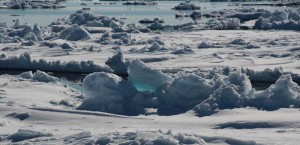Off balance: the CO2 and sea level seesaw – An interview with Dr Gavin Foster
The study “Relationship between sea level and climate forcing by CO2 on geological timescales” by Dr Gavin Foster and Professor Eelco Rohling which was this week published in the Proceedings of the National Academy of Sciences had quite an impact on the science websites and blogs.
In an interview in Katy Edgington (ScienceOmega.com), Gavin “expounded on the link between CO2 and the seas, and how the correlation exhibited in this study could influence our forecasts for the future.”
While sea level change is arguably one of the most long-lasting and significant impacts of anthropogenic climate change, long-range predictions of the change that can be expected as the oceans warm and the continental ice sheets melt are quite uncertain.“This is largely because the complex processes involved in the melting of the continental ice sheets are difficult to incorporate into climate models,” Dr Foster pointed out. “We currently rely on semi-empirical methods to describe their behaviour; methods which remain as yet untested.”
Dr Foster and his colleagues approached the problem in a slightly different way, by delving into the rich archive of the geological past to find examples of warmer worlds that could provide an insight into how the Earth may behave in a warmer future. Focusing on the relatively recent past – the last 40 million years – they minimised the impact of changes in continental configuration, for example.
“The main advantage of looking at the geological past, and what makes it worthwhile, is that it represents a reality – a state which we can be sure the Earth system once occupied,” explained Dr Foster. “It inherently includes all feedbacks involved in the system whether we currently know about them or not; this is not the case with modelling, of course, which draws directly on the state of our current knowledge.”
The inclusion of data from points at which the global temperature was increasing and decreasing allowed Dr Foster and co-author Professor Eelco Rohling – also from Ocean and Earth Science at the University of Southampton – the best chance of spotting trends and relationships.
“As many people are aware, CO2 is a potent greenhouse gas responsible for a significant portion of the greenhouse effect,” stated Dr Foster. “On geological timescales, the concentration of CO2 in the atmosphere is determined by subtle imbalances in the amount of CO2 coming out of volcanoes and the amount being removed by silicate weathering.”
Over the last 40 million years CO2 concentration has changed quite dramatically, from 1200 parts per million (ppm) 40 million years ago to 180 ppm during the last glacial maximum.
“We show here that ice volume and sea level, and hence global temperature, have changed in concert,” stated Dr Foster. “Correlation does not prove causation of course, but we have known from fundamental physics for over 100 years that if you change atmospheric CO2 concentration you change global temperature by ~1ºC per doubling. This basic response is amplified by other processes that operate in the atmosphere and the result is something like a 2–5ºC global temperature change for a doubling of CO2.”
Links
Follow us on Twitter
Recent Posts
- In the News : What a three-million year fossil record tells us about climate sensitivity
- Past evidence confirms recent IPCC estimates of climate sensitivity
- Crucial new information about how the ice ages came about : PR & Podcast
- 2014 Sino-UK Coevolution of Life and the Planet Summer School
- Past and Future CO2 – Reconstructing atmospheric Carbon Dioxide





